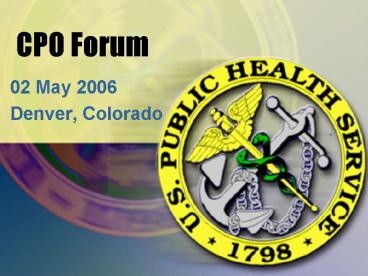CPO Forum - PowerPoint PPT Presentation
1 / 25
Title:
CPO Forum
Description:
PSC=14, SAMHSA=14, EPA=12, ATSDR=9, USDA=7, Interior=3, CIA=1, DoD=1 ... Commercials. Other promotional material. Request officers to complete an officer bio ... – PowerPoint PPT presentation
Number of Views:200
Avg rating:3.0/5.0
Title: CPO Forum
1
CPO Forum
- 02 May 2006
- Denver, Colorado
2
HSOs Are
- The 4th largest category (829)
- The most diverse category
- The future of the Corps!
Strength Through Diversity!
3
Who We AreHSOs By Rank
2004
4
Who We AreHSOs By Subcategory (N829 as of 10
APR 2006 )
5
Who We AreHSO Clinical Disciplines
6
Who We AreHSO Administrative Disciplines
7
Who We AreHSO BAS Disciplines
8
Where We WorkAgencies With gt15 HSOs
30
15
15
12
8
PSC14, SAMHSA14, EPA12, ATSDR9, USDA7,
Interior3, CIA1, DoD1
9
Where We Work States With gt30 HSOs
29 of HSOs work in MD or DC
10
How We Have GrownNew HSOs by Year of Entry
10 APR
11
Professional Advisory Groups to HS PAC
12
Transformation
- Where Are We So Far? - Timeline
- November 7, 2005 Decision-making meeting with
Department leadership - December 5, 2005 Announcement of decisions and
follow-on Implementation Planning Work Groups - January 18, 2006 - Secretarys Roll-out
- February 2006 Congressional Request for
increase in FY 07 Transformation budget - February 2006 White House Katrina Report
- March 8, 2006 Work Group reports completed
13
Transformation Work Groups
- Classification and Positions
- Chair CAPT Patricia Simone
- Sizing the Corps
- Chair RADM Sam Shekar
- Recruitment, Training, Career Development Chair
- CAPT Kerry Nesseler - Assignments
- Chair RADM Eric Broderick
- Readiness
- Chair RADM John Babb
14
Transformation Work Groups
- Work Groups met weekly from Jan 5 Feb 28, 2006
- HHS agencies with COs invited to designate a
member to serve on each work group. Members also
represented BOP, and Coast Guard - Each group also had representatives from OCCFM,
OSG/OCCO, and JOAG and staff support from the
Lewin Group - Participation included about 100 officers
- Categories (CPOs and PACs) were not directly
included in this process - A coordinating group composed of group chairs and
senior leaders also met weekly
15
Classification
- DECISION Officers should be grouped based on a
matrix of professional category and functional
group (i.e., Clinical, Applied Public Health,
Mental Health, and Research) - DECISION Billets should facilitate force
management with descriptions unique for each
position, but containing both general and
position-specific information billet development
and approval should be managed centrally
16
Sizing
- DECISION The size of the Corps should be 6,600
positions should be allocated across agencies
taking that into account
17
Recruitment and Training
- DECISION All avenues should be used including
central recruitment - DECISION A 2-week BOTC should be required of all
new officers training should be shared by agency
and Corps throughout officers career
18
Assignments
- DECISION A central Corps assignment system
should assist agencies - DECISION Positions should be designated as
either Corps, civilian, or mixed - DECISION A variety of incentives should be used
to fill 3H (hardship, hazardous, hard-to-fill)
positions
19
Readiness
- DECISION Implement a 4-tiered response
capability, exempt mission critical officers - Designate Secretary as the activation
decision-maker - Per Katrina Report Create 315 member Health and
Medical Response (HAMR) team - Will draw upon new Corps hires
- 36 million from central funds
- Proposed for 2007 Hurricane season
20
Readiness
- Tier One
- 5 Rapid Deployment Force (RDF) Teams of 105
officers will train and deploy as a unit, within
200 miles of - Washington, DC PHS-1 and PHS-2
- Atlanta Raleigh/Durham PHS-3
- Dallas Oklahoma City PHS-4
- Phoenix Albuquerque PHS-5
- 10 Secretarys Emergency Response Teams (SERTs)
of 30 centered in each PHS Regional Office - Report to point of departure within 12 hours of
notification
21
Readiness
- Tier Two
- Geographically dispersed
- 5 Applied Public Health Teams (APHTs)
- 47 officers per team
- A public health department in a box
- 5 Mental Health Teams (MHTs)
- 26 officers per team
- Provide mental health/behavioral health services
- Report to point of departure within 36 hours of
notification
22
Readiness
- Tier Three
- All other active duty officers
- Report to point of departure within 72 hours of
notification - Deploy to augment Tier 1 or Tier 2 teams or to
provide specific requested skills - Tier Four
- Officers in the Inactive Reserve Corps
23
Readiness
- All officers will be placed in Tiers 1, 2, or 3
- All officers will be on call every 5th month in a
rotating schedule - Mission critical officers will only deploy in
extreme events - OFRD has asked all officers to go the OFRD
website and fill out a brief questionnaire
related to Tier, roles, experience training - Applications will be reviewed by Team Leaders
- OFRD will contact supervisor and agency prior to
Tier 1 or 2 placement
24
Publicity
- ORC Macro under contract with HHS to do PR for
PHS - Print media
- Commercials
- Other promotional material
- Request officers to complete an officer bio
- Request a small number of officers for focus
groups - Request officers to participate in a videotaped
interview
25
QUESTIONS?































